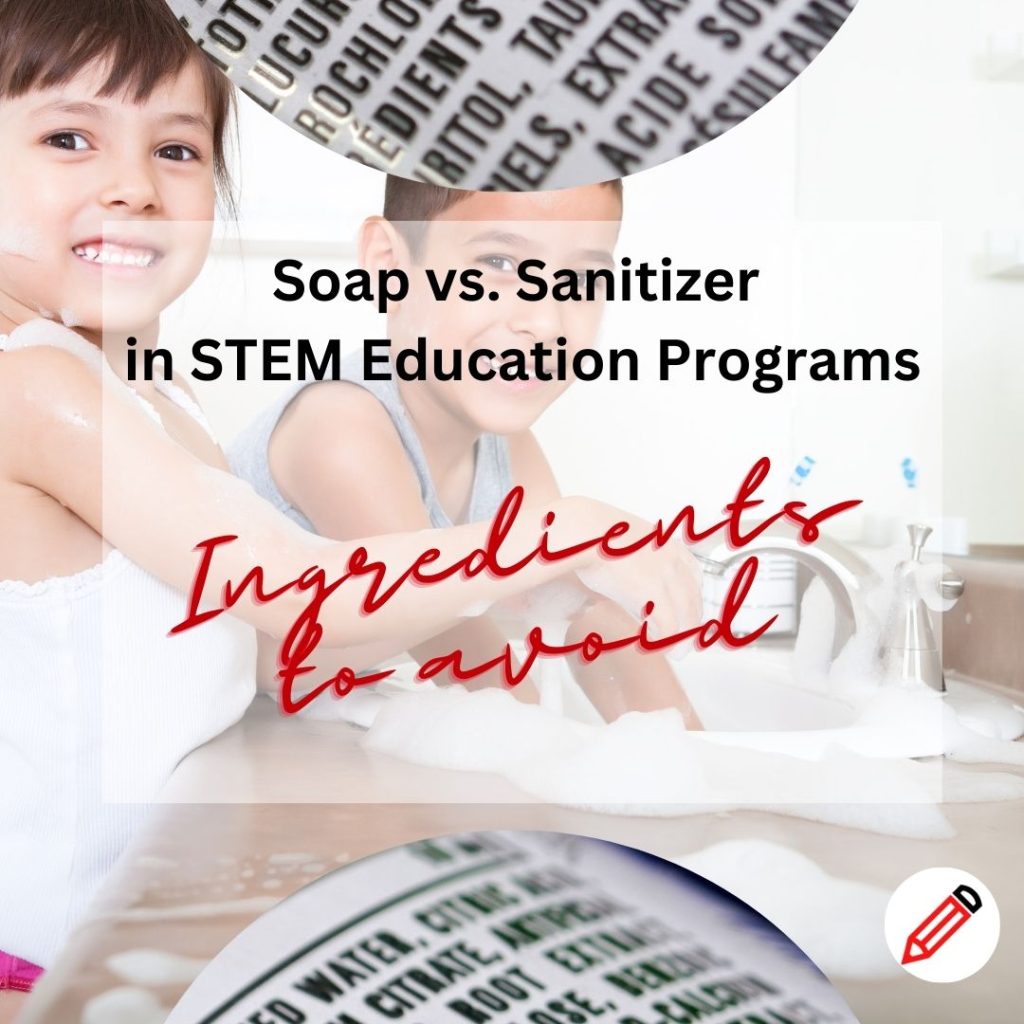In the fast-paced world of STEM education, where hands-on learning experiences are paramount, the question of whether students should wash their hands with soap or sanitize them before handling materials like LEGO is a topic of ongoing debate. Both methods aim to reduce the risk of germs and contamination, but they come with their own set of pros and cons. In this article, we explore the merits of washing hands with soap vs. sanitizer, while also examining the ingredients to avoid in sanitizers and soaps for optimal hand hygiene.
Washing Hands with Soap:
Washing hands with soap is a time-tested method for removing dirt, germs, and bacteria from the hands. Here are some of the pros and cons of this approach:
Pros:
- Effective Germ Removal: Soap works by breaking down the lipid membrane of viruses and bacteria, effectively removing them from the hands.
- Mechanical Action: The friction generated by rubbing hands together during washing helps dislodge dirt and germs from the skin’s surface.
- Natural Options: Natural hand soaps are formulated to be hypoallergenic, making them suitable for frequent handwashing without causing dryness or irritation.
Cons:
- Requires Water: Washing hands with soap requires access to running water, which may not always be readily available, especially in outdoor or field-based STEM activities.
- Time-Consuming: Proper handwashing with soap requires at least 20 seconds of vigorous rubbing, which may be perceived as time-consuming in fast-paced educational settings.
Sanitizing Hands:
Hand sanitizers offer a convenient and portable alternative to handwashing with soap. Here are the pros and cons of sanitizing hands:
Pros:
- Convenient: Hand sanitizers are convenient to use and require no access to water or towels, making them ideal for on-the-go situations or when water is unavailable.
- Quick Drying: Sanitizers typically evaporate quickly upon application, allowing for rapid disinfection of hands without the need for rinsing.
- Effective Germ Kill: Alcohol-based hand sanitizers can effectively kill a broad spectrum of germs and bacteria on the skin’s surface.
Cons:
- Limited Efficacy: While hand sanitizers are effective against many types of germs, they may be less effective against certain viruses and bacteria.
- Drying Effect: Frequent use of hand sanitizers containing high concentrations of alcohol can lead to dryness and irritation of the skin, particularly in individuals prone to sensitive skin.
- Residue Build-Up: Some hand sanitizers may leave a residue on the hands after evaporation, which can be perceived as unpleasant or sticky.

Ingredients to Avoid in Sanitizers and Soaps:
When selecting hand sanitizers and soaps for use in STEM education programs, it is essential to avoid ingredients that may pose health risks or cause skin irritation. Here are ten ingredients to avoid:
- Triclosan: A common antibacterial agent linked to hormonal disruption and environmental concerns.
- Parabens: Preservatives that may disrupt hormone function and have been associated with breast cancer.
- Phthalates: Chemicals used to increase flexibility in plastics, linked to developmental and reproductive toxicity.
- Methylisothiazolinone (MI): MI is a common preservative in cleaning products and can cause allergic contact dermatitis.
- Formaldehyde: A preservative and disinfectant that can irritate the skin and respiratory system.
- Fragrances: Synthetic fragrances can contain hundreds of chemicals, some of which may trigger allergic reactions and respiratory issues.
- Artificial Colors: Synthetic dyes and colors may cause skin irritation and allergic reactions.
Choosing products with the fewest ingredients is one allergy-friendly strategy, that generally makes sense for working with diverse learners.
In conclusion, the choice between soap vs. sanitizer depends on various factors, including accessibility, efficacy, and skin sensitivity. While both methods have their advantages and disadvantages, the key is to prioritize proper hand hygiene practices to minimize the risk of germ transmission in STEM education settings. By avoiding harmful ingredients in sanitizers and soaps, educators can ensure a safe and healthy learning environment for students, promoting their overall well-being and success in STEM education programs.
===
Interested in teaching medical literacy pain free? Shop medical literacy resources!

This article was drafted by ChatGPT and edited by Joan Lee Tu, the founder of MedULingo.com.
You may also be interested in the following:
Preventing Contact Allergies in Kids: A Guide for Parents – FREE DOWNLOAD
Preventing Contact Allergies Tip Sheet – FREE DOWNLOAD
Consumer Literacy Scavenger Hunts – FREE DOWNLOAD
Safe Science: Guidelines for Handling Chemicals in Kids’ Science Activities
Safeguarding STEM Learning: Best Practices for Sanitizing LEGO in Education Programs
The Great Debate: Soap vs. Sanitizer in STEM Education Programs
How to Accommodate People with Contact Allergies
Why Medical Literacy Needs To Be In Your School STEM Program
Why a Robust STEM Education Program Needs to Include Medical Literacy
20 Benefits of Including Medical Literacy in Your STEM Program
How Medical Literacy Activity Books Empower Learners in STEM Education
How to Empower Future STEM Innovators with Self-Directed Learning in Medical Literacy
Why STEM Education Needs Medical Literacy to Foster Healthcare Innovators
Why You Need Diverse Learning Modalities for Medical Literacy

